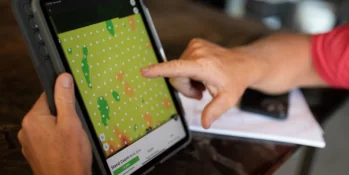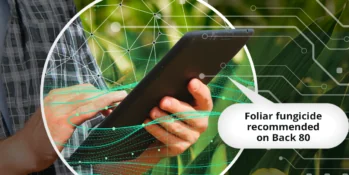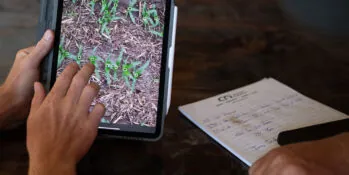

I farmed for 27 years, with my last year being 2016. Those nearly three decades didn’t just give me an understanding of the challenges farmers face, they gave me first-hand experience and appreciation for what it takes to farm.
We weren’t using a lot of technology, but we were always looking for opportunities to improve what we were doing. Every farm is always looking for ways to improve efficiency and productivity.
Our operation was using GPS. We could variable rate the seed on the go. It was a quick transition, but one that allowed me to stay connected to agriculture while exploring new technologies. I say that everything I know about ag tech Taranis has taught me.
I think my background helps with the conversation with farmers who may be interested in Taranis. I’ve had the same questions they have.
It took me a long time to make the decision to stop farming. I think once farming is in your blood, it’s there forever. After I decided to quit farming, I went to work for a biotech company – I thought about leaving agriculture altogether, but couldn’t do it – I went to plants. And then after some time in the biotech world, I interviewed with Taranis in the spring of 2021 and by June 14 of that year, I was working for them.

I’m the only Taranis representative south of Kentucky, which means I deal with a diverse range of crops and agricultural practices. I have lots of cotton interspersed because of course, I’m in the Cotton Belt. My territory includes everything from cotton to corn, soybeans, and even sugar cane in Louisiana and Florida. Each crop and region has its own unique challenges, and I need to understand them all to effectively serve our customers. The geography and crops in my territory make it challenging and definitely unique to the rest of Taranis’ business portfolio.
My background in farming tells me that there are things you can’t control: the weather and commodity prices.
The one thing you can control is how efficiently you can deliver the commodity you’re growing. And that’s what Taranis offers a farmer: the ability to improve efficiency and accuracy and do it on the spot.
Taranis helps farmers and retailers optimize their operations, particularly in areas like the emergence of seeds and the placement of fertilizers and crop protection products. It’s about making the most of the resources we have – genetics, fertility, drainage, water, and crop protection – by applying them more efficiently.

I’m optimistic about the adoption of agricultural technology in the South. I think we’re on the tip of an iceberg. We’re going to see some fundamental shifts in agriculture in 2025, at least within my territory; 2025 is going to be a big year for change because it’s going to have to be.
Commodity prices don’t look good and inputs aren’t getting any cheaper, so farmers are going to have to figure out how to stretch those input budgets as far as they will go. Taranis helps them do that.
We’re slower to adopt new technologies in the South, but when we do, it tends to snowball.
I also see, in the next five years, Taranis playing a crucial role in helping retailers expand their reach and retain young talent. It’s about using better tools to touch more people and cover more acres efficiently. As labor becomes scarcer and profit margins tighter, the efficiency that Taranis provides will become even more critical.
Ultimately, Taranis brings farmers and those who can best help them together to deal with real problems. Taranis provides valuable information that helps both farmers and retailers make better decisions and become more profitable.
And in this business, that’s what it’s all about.

The off-season is more than just a break from the busy growing season—it’s the perfect time to analyze the past year and set a strategy for the one ahead.

Here are the top five ways AI, and particularly Ag Assistant, is reshaping the future of agriculture.

AI-powered crop intelligence transforms data into information that can be used to develop management plans for the growing season – the transition turns extensive datasets into extensive opportunities…for retailer-farmer communication, for next season’s management strategy and long-term profitability.